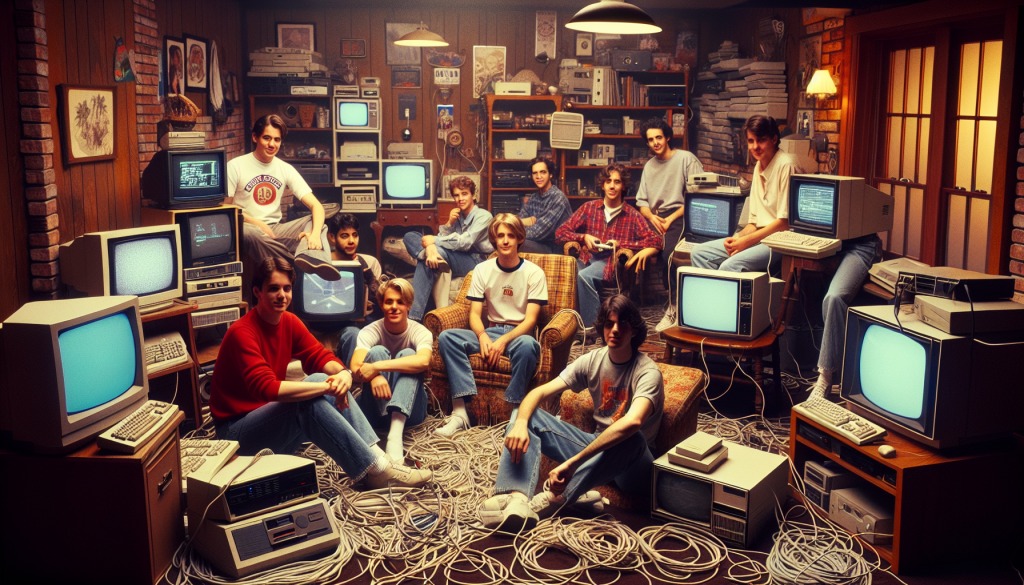The Importance of Sound Design in Gaming
When we think about the elements that make a video game truly immersive and captivating, we often focus on the graphics, gameplay mechanics, and storyline. While these aspects are undoubtedly crucial, one element that is sometimes overlooked but plays a crucial role in enhancing the overall gaming experience is sound design. Sound design in gaming is the art of creating and implementing audio elements such as music, sound effects, and dialogue to amplify the atmosphere, emotions, and gameplay.
Sound design has the power to transport players into the game world, making them feel like they are a part of the action. It helps to create a sense of presence and realism, heightening the emotional connection and engagement with the game. Imagine playing a horror game without the eerie music and spine-chilling sound effects; it just wouldn’t have the same impact.
One of the key factors in sound design for gaming is the understanding of psychoacoustics, which is the study of how we perceive sound. By leveraging psychoacoustic principles, sound designers can create audio experiences that are not only realistic but also optimize the player’s perception and immersion within the game.
For instance, the careful use of spatial audio techniques can simulate the direction and distance of sounds, allowing players to locate specific in-game objects or enemies. This adds a layer of depth and realism to the gaming experience, making it feel more dynamic and interactive. By using binaural audio, sound designers can even create a three-dimensional soundscape, further enhancing the immersion and sense of presence.
In addition to psychoacoustics, sound designers utilize a variety of tools and techniques to achieve their desired effects. They work with digital audio workstations (DAWs) to create and manipulate sounds, using techniques such as layering, equalization, and modulation. They also incorporate Foley sound recording, which involves capturing real-world sounds like footsteps, weapon noises, or environmental effects to add authenticity to the game.
Music is another essential aspect of sound design in gaming. It sets the mood, evokes emotions, and guides the player through different game states. From intense battle music to serene ambient tracks, the right music can greatly enhance the overall gaming experience and make it more memorable.
As technology continues to advance, the future of sound design in gaming looks incredibly promising. With the advent of virtual reality (VR) and augmented reality (AR) gaming, sound designers have even more opportunities to push the boundaries of immersion. They can leverage spatial audio to create realistic and believable virtual environments where players can truly feel like they are inside the game.
Furthermore, as game developers strive for inclusivity, sound design plays an essential role in making games accessible to players with disabilities. By incorporating features like closed captions and audio cues, sound designers can ensure that everyone can enjoy and fully engage with the gaming experience.
In conclusion, sound design is a critical element in gaming that often goes unnoticed but has a profound impact on the overall experience. It adds depth, emotion, and realism to the game world, making it more immersive and engaging for players. By understanding psychoacoustics, utilizing various tools and techniques, and embracing emerging technologies, sound designers continue to shape the future of gaming. So next time you play a video game, take a moment to appreciate the incredible work that goes into creating the audio experience that enhances your gameplay.
The Role of Psychoacoustics in Creating Immersive Experiences
Have you ever played a video game that completely transported you to another world? One where every sound, from the creak of doors to the distant rumble of thunder, made you feel like you were truly a part of the virtual environment? This level of immersion is all thanks to the role of psychoacoustics in creating immersive experiences in gaming. But what exactly is psychoacoustics? Simply put, it is the scientific study of how our brains perceive and interpret sound. In the context of gaming, psychoacoustics is crucial for creating a realistic and captivating audio experience that makes players feel like they are right in the middle of the action. One of the fundamental principles of psychoacoustics is spatial sound perception. Our brains are capable of localizing sounds based on the subtle differences in arrival time and intensity between our ears. This is why we can easily tell if a sound is coming from the left, right, or somewhere in between. In gaming, this spatial perception becomes essential for creating a sense of direction and distance, allowing players to pinpoint the source of sounds accurately. To achieve accurate spatial sound perception, sound designers employ various techniques and tools. One of the most commonly used techniques is called binaural audio. Binaural audio involves recording audio using microphones placed in a dummy head, which replicates the exact positioning of human ears. This recording technique allows for an incredibly realistic and immersive audio experience when played back through headphones, as it replicates the natural cues that our brains use to localize sounds. Another important tool in sound design for gaming is the use of surround sound systems. By strategically placing speakers around the player, sound designers can create a three-dimensional sound field that further enhances the sense of immersion. With surround sound, players can hear sounds approaching from behind, above, and all around them, making the gaming experience truly come to life. In addition to spatial sound perception, psychoacoustics also plays a role in the emotional impact of sound in gaming. Our brains are wired to associate certain sounds with specific emotions. For example, a low rumble might evoke a sense of danger or anticipation, while a soft melody can create a feeling of tranquility. By leveraging these emotional associations, sound designers can enhance the overall mood and atmosphere of a game, making it more engaging and memorable for players. To achieve the desired emotional impact, sound designers utilize a wide range of techniques, including sound layering, dynamic mixing, and the use of adaptive soundtracks. By carefully crafting the sonic landscape of a game, they can elicit specific emotional responses from players, further immersing them in the gaming experience. As technology continues to advance, the future of sound design in gaming looks promising. With the advent of virtual reality (VR) and augmented reality (AR) technologies, the potential for creating even more immersive audio experiences is immense. Imagine exploring a virtual world where every sound is seamlessly integrated with your movements and actions, making you feel like you are truly living in the game. In conclusion, the role of psychoacoustics in gaming cannot be overstated. By understanding how our brains perceive and interpret sound, sound designers can create immersive experiences that transport players to another world. Through techniques such as binaural audio and surround sound, they can accurately replicate spatial sound perception, while also leveraging emotional associations to enhance the overall mood of a game. With the advancements in technology, the future of sound design in gaming is bound to be even more exciting and immersive. So next time you play a video game, take a moment to appreciate the intricate sound design that goes into creating that truly immersive experience.Techniques and Tools Used in Sound Design for Gaming
When it comes to creating an immersive gaming experience, sound design plays a crucial role. From the subtle rustling of leaves to the booming explosion of a rocket launcher, sound effects can transport players into a whole new world. In this section, we will explore some of the techniques and tools used in sound design for gaming.
1. Foley Artistry
One of the key techniques in sound design for gaming is foley artistry. Foley artists use various objects and materials to create sounds that mimic the actions and movements of characters and objects in the game. For example, to recreate the sound of footsteps on different surfaces, foley artists might use different types of shoes on different materials such as gravel, wood, or concrete. This attention to detail adds a layer of realism to the gaming experience.
2. Layering and Mixing
Layering and mixing are essential techniques in sound design for gaming. By layering different sound elements together, sound designers can create complex and dynamic soundscapes. For example, the sound of a roaring dragon might consist of multiple layers, including a base layer of a lion’s roar, mixed with elements of fire crackling and deep rumbling sounds. Mixing involves adjusting the volume, panning, and equalization of individual sound elements to create a balanced and cohesive audio experience.
3. Spatial Audio
In modern gaming, spatial audio is becoming increasingly important in creating a realistic and immersive experience. Spatial audio refers to the ability to perceive the location and movement of sound sources in a three-dimensional space. This technique allows players to accurately pinpoint the direction of in-game sounds, such as footsteps approaching from behind or bullets whizzing past their ears. To achieve spatial audio, sound designers use techniques such as binaural recording and the implementation of positional audio algorithms.
4. Adaptive Audio
Adaptive audio is a technique that allows the sound design to dynamically respond to the player’s actions and the in-game environment. This technique helps to enhance immersion and create a personalized experience for each player. For example, if a player enters a dark and eerie cave in the game, the background music and ambient sounds can change to reflect the tense and foreboding atmosphere. Adaptive audio can be achieved through the use of scripting and audio middleware tools.
5. Sound Libraries and Sampling
Sound designers often rely on sound libraries and sampling to find and create the perfect sound effects for their games. Sound libraries contain a vast collection of pre-recorded sound effects that can be easily integrated into the game. Additionally, sound designers can also create their own sound effects by recording and manipulating real-world sounds. Sampling involves taking small segments of existing sounds and manipulating them to create new and unique sound effects. This technique allows sound designers to create custom sounds that fit the specific needs of their game.
As technology advances, the tools and techniques used in sound design for gaming will continue to evolve. From advancements in spatial audio to the development of more sophisticated sound libraries, the future of sound design in gaming looks promising. It is an exciting time for both sound designers and gamers alike, as the power of sound continues to shape and enhance the gaming experience.












